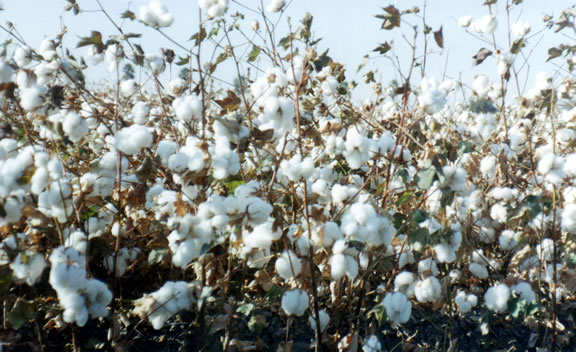
Agricultural News
Oklahoma Cotton Farmers Join Farmers Throughout the Cotton Belt in Planning to Plant More Cotton in 2010
Sun, 07 Feb 2010 14:40:31 CST
 U.S. cotton producers intend to plant 10.1 million acres of cotton this spring, up more than 10 percent from 2009, according to the National Cotton Council's 27th Annual Early Season Planting Intentions Survey. (see PDF attachment that can be clicked on and viewed at the bottom of the page.)
U.S. cotton producers intend to plant 10.1 million acres of cotton this spring, up more than 10 percent from 2009, according to the National Cotton Council's 27th Annual Early Season Planting Intentions Survey. (see PDF attachment that can be clicked on and viewed at the bottom of the page.)
According to the NCC, Oklahoma cotton producers will jump planted acreage from 205,000 acres this past year to 259,000 acres this coming spring for the 2010 growing season.
Upland cotton intentions are 9.9 million acres, an increase of 10 percent from 2009, while extra long staple (ELS) intentions of 176,000 acres represent a 24 percent rise. The results were announced at the NCC's 2010 Annual Meeting, which began today at the Peabody Hotel here.
Assuming an average abandonment rate of 11.5 percent, total upland and ELS harvested area would be about 8.9 million acres. Applying state-level yield assumptions to projected harvested acres generates a cotton crop of 15.5 million bales, compared to 2009's total production of 12.4 million bales. Assuming average seed-to-lint ratios, 2010 cottonseed production is projected at 5.2 million tons, up 1 million from last year at 4.2 million.
The NCC survey was mailed in mid-December of 2009 to producers across the 17-state Cotton Belt. Survey responses were collected via return mail and electronically through mid-January asking for their intended acreage for 2010 and their plantings of other crops in 2009.
Based on survey results, all four production regions show intended upland cotton planting increases from last year. The West shows the largest percentage expansion of 26.6 percent; however, the largest acreage increase is in the Southwest at 475,000 or up 9.1 percent. The two other regions, the Southeast and the Mid-South, indicate rises of 12.2 percent and 8.4 percent, respectively.
NCC Senior Economist Dale Cougot emphasized that, "prevailing market conditions this year are more favorable for cotton prices than some of the main competing crops versus the previous couple of years. Part of this is due to further tightening of world and U.S. cotton supplies, while other competing crops experience a reduction of pressure on their supplies from either higher production or lower demand. It is still early to fully evaluate the impact of weather, ground moisture and water availability, but most of the Cotton Belt at this point is better off than in the last several years -- which may alleviate some of the drag on acres and yields. At this time, planting seeds are still in the sack and growers will continue to monitor market conditions comparing relative crop prices and cost in the coming weeks that could alter their final decision."
Survey respondents through the Southeast indicated expansion in acreage, except for Florida, as producers return to peanuts. Alabama and North Carolina reported the largest percentage swell at 20 percent for both with shifts coming from reductions in corn and soybeans. Growers in South Carolina, at 13 percent, and Virginia, at 10 percent, look to increase acres, mainly at the expense of soybeans, while Georgia, at 9 percent, is taking acres from corn.
All the Mid-South states intend to expand cotton acres. However, the magnitude varies from a modest 0.4 percent in Arkansas to 19 percent in Mississippi, followed closely by Tennessee at 18 percent, Missouri at 8 percent and Louisiana, which is adding 1 percent. Missouri growers' expansion is at the expense of corn, whereas Louisiana and Mississippi producers noted both corn and soybeans. Tennessee and Arkansas acres are the results of cotton following acres that were devoted to wheat and soybeans double cropping in 2009.
Southwest growers expressed intentions of expanding the largest area by 475,000 acres to 5.7 million acres. A large part of the growth came from the subsiding drought in Texas (+8.3 percent), while Kansas' (+19.0 percent) and Oklahoma's (+26.3 percent) propose shifts away from wheat.
"In light of the fact that Texas will account for 54 percent of U.S. cotton planted area and has a wider variance in abandonment acres and yields, it could swing the crop estimates either direction by several million bales this season," Cougot stated.
All of the Western region states showed upland planting increases, with the region projected to advance by 27 percent. California's upland planted area intentions of 37 percent breaks a five-year declining trend for that state and -- represents the largest percentage growth of all Cotton Belt states. This stems from nervousness in tomato prices and dairy feed production but hinges on water availability, which could swing acres either way. Survey responses also revealed enhancements in Arizona (+20 percent) and New Mexico (+32 percent) upland area.
Increases in the four states producing ELS cotton are coming in response to better pima prices, which are finding support in strong export demand and tighter stocks. California leads the way with an increase of 28 percent. Texas (+7 percent), Arizona (+5 percent) and New Mexico (+4 percent) report smaller gains.
00006_10amplantintentionsrel.pdf
WebReadyTM Powered by WireReady® NSI
Top Agricultural News
More Headlines...



















